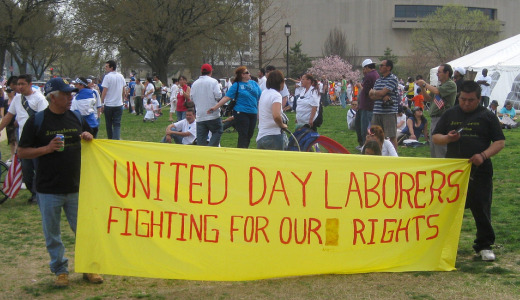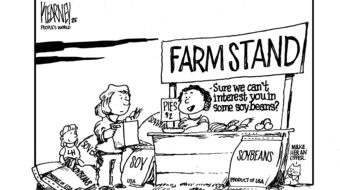
Book Review
“Catching Out. The Secret World of Day Laborers”
By Dick J. Reavis
Simon & Schuster, 2010
Day labor status is being forced on more and more full-time American workers, whether they want it or not. In his new book, English professor Dick J. Reavis tells precisely what day labor is like. He also summarizes what little is known about this growing sector of the working class, and he adds cogent recommendations to head off the trend toward disaster.
Reavis’ regular job is at the University of North Carolina, but he’s a Texan through and through. His book is dedicated to his wife and, then, “to John Stanford, who set an example of decency.” Stanford, a contributor to the People’s World, is well known in Texas activist circles.
How does Reavis know about day labor?
To gather the information and insight for this book, the author spent considerable time posing as a down-and-out day laborer. Most of the book, which reads rather like Steinbeck’s “Cannery Row” or “Tortilla Flats,” consists of descriptions of the jobs he was assigned and the people he worked with. He fully absorbed every nuance of day labor life and shares it with us in his book.
What do the statistics say?
The bonus is his summary of virtually everything known about contingency workers, scanty as it is. He points out that the clearest example of what happens comes from Japan, where “life-long” employment was the norm until their big economic crisis. In the 20 years since then, Reavis finds, fully one-third of the Japanese have become contingency workers!
Here in the U.S., Reavis reports that 20 percent of the workforce is on contingency, but that represents “a sixfold increase since 1971 when the temp industry came into its own.” He points out that contingency work takes a bigger bite out of the full-time workforce with every economic crisis. Obviously, this one, the worst crisis since the Great Depression, will result in several big bites!
What do the bosses say?
The bosses’ spin on contingency work was reflected in an April 19 article by Michael Luo in The New York Times. Luo says, “Many embrace part-time work.” To the extent that people don’t “embrace” being shoved out of regular employment, Luo rationalizes that it’s just a trend without a cause. He writes, “The notion that the nature of work is changing – becoming more temporary and project-based, with workers increasingly functioning as free agents and no longer being governed by traditional long-term employer-employee relationships – first gained momentum in the 1990s.” Why? He doesn’t say.
What can we do?
Reavis promoted his book on the Dallas KNON radio program “Workers Beat” on April 19. He completely smashed the bosses’ preposterous view by stating flatly that the contingent workforce is growing for one reason and one reason only – because bosses can make more money that way! The day laborers, and don’t forget that he knows them intimately, desperately long for full-time employment!
Reavis said that good national health care would go a long way, and that Americans could benefit from a European law, in effect for years, that stops employers from paying contingency workers less than full-time employees. It works similarly to our Davis-Bacon law for construction workers, and requires that a “prevailing wage” be paid for all work. Reavis warned that everyone should learn more about the contingency workforce and fight for laws that would give day laborers the possibility of organizing. “Organizing is the only real solution,” he said.
Photo: http://www.flickr.com/photos/87913776@N00/ / CC BY 2.0








